Jonah Feingold On His Feature Directorial Debut DATING & NEW YORK And The Dichotomy Of Modern Dating
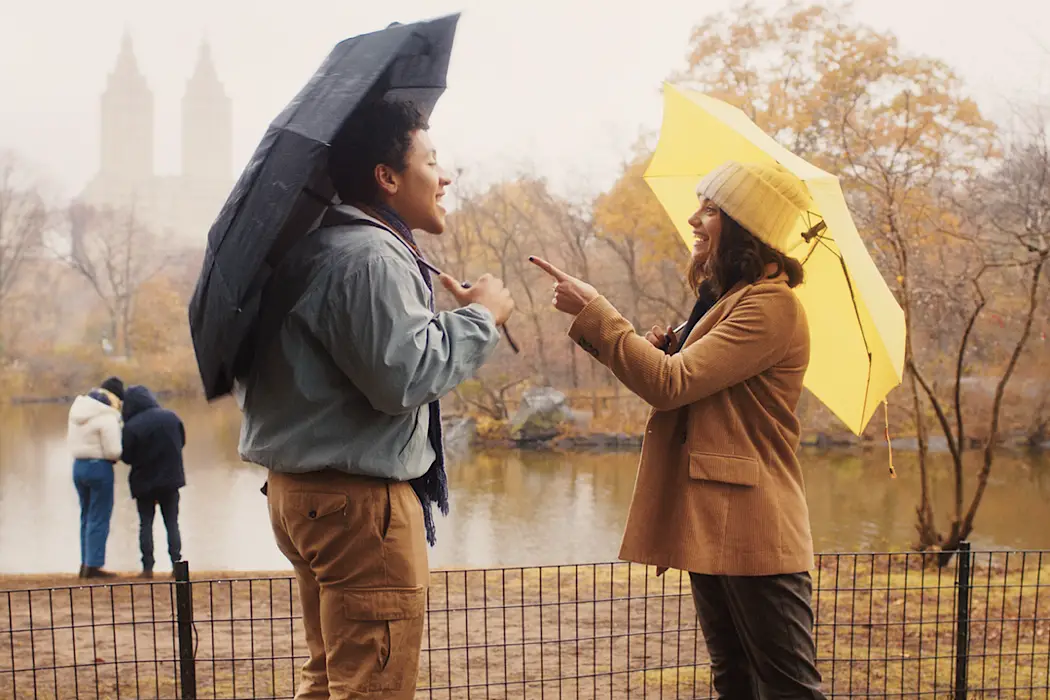
Reyzando Nawara is a passionate film and TV enthusiast from…
In Jonah Feingold‘s debut feature Dating & New York, two millennials New Yorker, Milo (Jaboukie Young-White) and Wendy (Francesca Reale), draw up a “friends with benefits” contract after meeting on a dating app called Meet Cute. Though the two initially agree that feelings should not be involved, they eventually do and make everything more complicated.
While the premise above sounds familiar, the film is actually anything but. Feingold finds a way to reinvent the romcom tropes by giving a modern spin to it both visually and narratively. Text messages pop up on the screen, a classical score gives the film a fairytale touch, relatable cynicism about dating culture adds depth and realism to the story. It’s a cute and adorable romantic comedy with two stellar leads.
We recently had the pleasure of speaking with Feingold to discuss the movie, his creative process of combining old romcom tropes with modern twists, the complexity of modern dating, and writing New York as a character.
Reyzando Nawara for Film Inquiry: Dating & New York is your directorial debut, so I wanna start at the beginning. How did you settle on this particular story for your first feature?
Jonah Feingold: Great question. I think when you’re trying to make a movie as a first-time filmmaker, there are two things that you need to consider: the first is how the hell are you gonna make this movie, and the second, what is your entry into the cinematic universe going to be as your first film. And Dating & New York came together in sort of a perfect combination of these two ways. I knew I had to make a movie that was going to be shootable in the sense that it didn’t take place underwater or it was not this epic war movie. It’s an indie movie. It’s an indie budget. And I think that that is important because you can get caught up and trying to make your movie for a very long time, and it’s very tough to enter the world of feature-length film directing especially when your project is high budget.
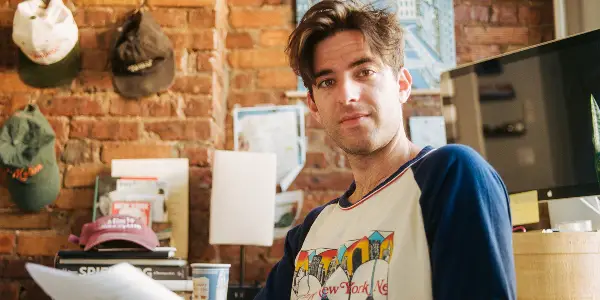
When you immersive yourself in the world of filmmaking, you also wanna ask yourself, “What is it that you want to contribute to the world of cinema?” For me personally, I became very passionate about romantic comedy after seeing the early works of Nora Ephron and Nancy Meyers. I was growing up in New York and then I went to film school and then I came back to New York and I was sorta navigating the dating space, and I haven’t really seen a movie that I thought accurately depicted the conversations, intimacy, and minutiae of technology that my friend and I were experiencing whether on dating apps or on Instagram. So the idea of Dating & New York was to explore this.
I want to make a movie that takes a very familiar premise — the friends with benefits romantic comedy — and perhaps add a unique overall perspective to the ways that this kind of story can be told. Whether that’s with a text message sequence or with a very classical score or with subverting the way that this movie ends. And that’s sorta the impetus for the movie.
Your love for classic romcoms is very apparent throughout the movie, but as you said, you also add your own modern spin to the story. How was your creative process of combining these old, familiar tropes with the modern ones?
I love the genre dearly and I also love movies in general. You know how sometimes when you’re on a date and you’re asked what your favorite me is and you don’t know how to answer it? I understand there’s a lot of movies out there and it’s tough to choose just one or two that you really love, but I’m not that kind of guy, I can answer that question very easily. My favorite movie of all time is a film called Hook, and my second favorite movie is When Harry Met Sally… I also love The Lion King, 101 Dalmatians, Pirates of the Caribbean.
I know what I love, so when figuring out the style of the film, I just looked at all the things that I personally really enjoyed — and I really enjoy the most the way fairytales are told, like in Cinderella or even in His Girl Friday. I like how the characters in When Harry Met Sally… are navigating this very strange friendship romantically or the way that Frances Ha just explores different locations in New York. So my process was simply just ticking all the things that I personally loved and then also added the unique way of how I see the world, which is mostly optimistic, and perhaps self-referential and even a bit in-your-face.
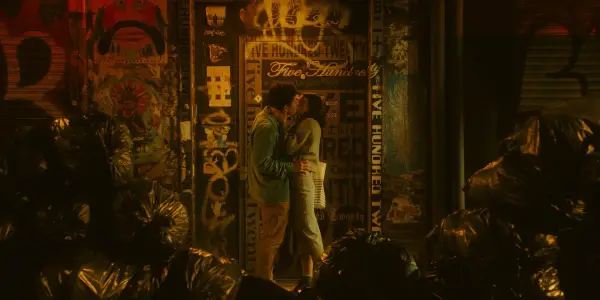
But I also do wanna say that a lot of the tones of the film come from the other voices involved. I’m a guy trying to write a 20-something millennial young woman like Wendy, so I’m not really a hundred percent qualified to do that. But you want people to relate and you want to feel authentic to their voices. That’s why crafting these diverse characters in this world was actually a collaborative process with Francesca and my cinematographer and my editor, as well as all these women that were on our crew.
The movie is very sweet and cute, and as you said, it has plenty of fairytale references. But on the other hand, it’s also cynical in that it talks about how dating actually sucks. Was this always your intention to show the dichotomy of dating?
There is an irony to the movie — it’s a fairytale about modern dating, but modern dating is not a fairytale. So ultimately, that cynicism is what I’m trying to convey. Wendy has a line to Milo where she says, “You idealize and then you devalue,” and I think that that’s really the root of all these modern dating stuff. While watching the movie, we all perhaps want this prince charming for this fairytale ending, but that’s not the way that the world works. No one has really ever found that. But at the same time, I do believe that you can find true love even though it’s sometimes can be more complicated than just, say, bumping into each other at a cafe.
The cynicism that Wendy and even Milo have — he’s a character who says he wants cuddling and emotional connection, yet at the same time he’s booty-calling his neighbor to come upstairs cause they have this sort of sexual relationship, but then didn’t he also say that he’s in love with Wendy? — is to say that in a relationship we’re all kind of like our own worst enemies. But we’re all in it together, and that’s the point. We’re all going through this and even though it’s gonna be a bumpy road along the way, it will be okay in the end. As you said and as the characters said, dating can suck.
In the film, the central relationship is between Milo and Wendy. But we also get a glimpse into Jessie and Hank’s, which, in a lot of ways, feels like the total opposite to Milo and Wendy’s. Why is it significant to show these two different kinds of romantic partnerships in the movie?
That’s a great observation. The idea for Jessie and Hank was to show that even though they’re dating in the internet era like Milo and Wendy, there can also be no contracts or excessive text messaging or leaving someone on read, but just the basic beats of romance with its ups and downs — you fight but then you makeup and get over it and even ultimately move in together like you have this super solid relationship.
When you take a look back at the movie, you’ll realize that Jessie and Hank’s timeline is really there to help surface how long Milo and Wendy have been running around in the same circle together. The same amount of time that this couple met then moved in together then took an even bigger step at the end of the movie is the same amount of time that Milo and Wendy have just been like, “Wait, what are we doing? I like you,” “No, you don’t. I like me.” So eventually, the intention of showing Jessie and Hank’s relationship is to create a contrasting perspective of what perhaps a modern relationship can be.
You set the story in New York, and what I love about it is that you use it not just as a location, but it feels like a character. Watching the movie reminded me a lot of Noah Baumbach and Alex Ross Perry’s works. How did you make sure that New York was captured in a way that was not just limited as a setting?
[laughing] It’s an honor to be in the same sentence as those filmmakers. I just love the tropes of New York being a character. Sometimes it can be as simple as you pointing a camera on the street of New York and you’ll feel like you’re there. In this film, it’s mostly a testament to our wonderful cinematographer Maria Rusche and also our production designer Michelle [Li] that New York ends up becoming more than just a location.
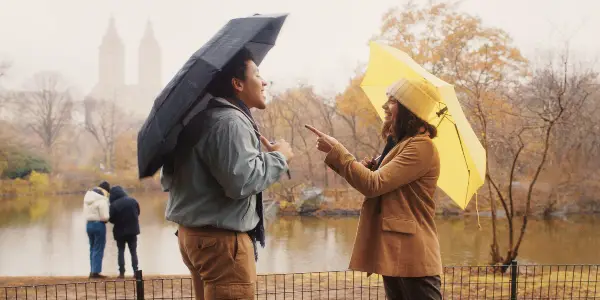
I want New York to literally be a character in the movie but in a way that feels fresh, and how so? Well, you have the subway sign that talks to the characters about what they’re really thinking. Then you have the therapy session on the sidewalk which I think is a wonderful moment that our production designer knocked out of the park — yes, it was a therapy set on a street but it still looked like it could be there for real, and that’s really hard to do. Never for a second that I think as an audience member where I’m like, “Wait, oh, they built the set,” because it still kinda feels organic.
I think that that’s what we tried to do to elevate New York as a character trope, which is literally making it a living, breathing sort of mischievous Loki — I don’t know if you watch Loki, but New York is like a Loki in our movie. When you spend time in New York, you’d feel like there’s this weird New York god that’s controlling your life, and we want to sorta play with that and make New York an active participant in the story even beyond just being a character. And I think in future work, I’d like to keep exploring that, to show how different things can happen in this city.
Visually, you play with a lot of styles. There’s a text message coming into life, then there’s also some kind of fantasy sequence. Tell me about how you and your cinematographer established the visual language for the film.
Fun fact, there’s no handheld shot used in the movie. I think one of the reasons people think it’s timeless is because we want to have this storybook narrative sorta mimic ‘90s commercial films in a very solid way. And even though I love handheld movies, I think the look that I wanted to capture could only be achieved if I didn’t use handheld shots. That’s why everything is on sticks, everything is brighter than it probably should be. Maria, our brilliant cinematographer — you can look at her work and you’ll notice that they’re all incredibly different — has such a unique visual voice no matter what the camera is.
The way we shot the movie was by doing it spherically, and we used all sticks or dolly and a lot of backlight for our characters. I also wanted to keep it always dynamic. I wanted the camera to move in ways that you weren’t necessarily expecting it to move in a rom-com. The camera is kind of a participant in the movie — it’s watching the story unfold. Every visual element of this movie is supposed to kind of feel like it’s trying to get something out of the character almost in the way that The Office might do it, but without the zooming in and out. We just wanna make the audience a part of the experience as they’re watching these two characters do their thing.
Can you talk a little bit about how did you settle on Francesca and Jaboukie as your lead actors? What was it about them that you feel would capture the love story you wanted to explore?
When I would see Francesca’s work, I felt that she had a very New York quality to her like Elaine from Seinfeld, but minus using humor as a defense mechanism. There’s a lot of relatable truth to Francesca, and I think that that’s where I knew she was Wendy. I could see her falling in love with somebody, but I could also see her having her wall up before allowing herself to do that.
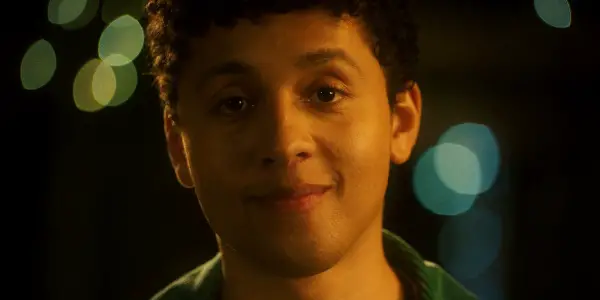
And for Milo — you can just look Jaboukie in the eyes and you know he’s the kind of person that would be there for you when you’re down and when you’re up. When I got tacos with him, I was like, “This is a friend that I could call when I’m in need of a laugh or when I’m going through a rough spot.” Milo is the kind of character that I think we all wanna be friends with, and as a result, Milo wants to be in our lives as well. But on the other hand, he’s also this person who overromanticizes things — he wants cuddling and companionship. To me, that’s what I’m looking for in Milo, and Jaboukie really captures that in his performance. He’s such a kind, charming person.
Continuing the conversation about the character. I love that Wendy is unafraid to tell Milo what she wants and isn’t scared to be frank about protecting her feelings. But usually, in a romcom, when the female lead acts this way, people end up villainizing her. How did you make sure that wasn’t the case?
It all really just started from the truth, and it was also a huge testament to Francesca as the brilliant actor that she is. We were always wondering what Wendy wants and what she’s afraid of, and Wendy is afraid of getting her heartbroken again. We can all relate to that, we can all relate to having to go through a breakup. She’s like, “Get me away from having ever to deal with that.” Wendy is not afraid to speak her mind. She knows exactly what she wants. So once we were able to figure that out, everything else sorta fell into place.
While we were filming, I told Francesca and Jaboukie that these characters are just characters in a movie and that they can sing their line and spin and take things bigger. I always would say, “Go big and let me take you down. Let me start at twelve out of ten and just go back down from there.” And once they felt comfortable enough to do that sort of thing, we started getting these wonderful moments between them.
There’s one moment in the movie that I find really intriguing. It’s the one that takes place in the ice cream shop where Milo and Wendy are having a debate on choosing just one flavor or trying everything. Tell me more about crafting that scene.
Yes, that’s a great scene. Funny enough, that was the first scene that Francesca and Jaboukie did together. For the scene itself, there was this idea that the ice cream is a metaphor for a relationship — I should tell you that it’s not easy to shoot at an ice cream store because the ice cream melts cause you have to turn off the fridge so it doesn’t make a sound [laughing]. I love that scene because it’s an interesting point in their relationship where they both are trying to make sense of each other, and that was exactly what was happening in reality too — they just had met each other.
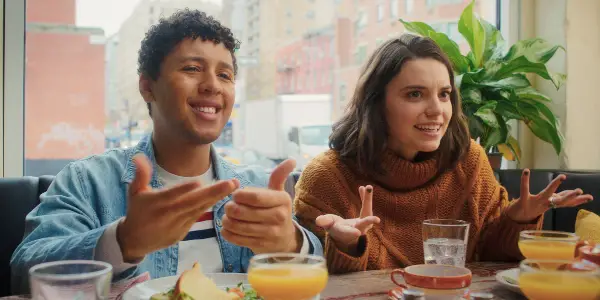
I think Jaboukie was on day three, and Francesca was on day one, so they weren’t exactly friends yet. But it’s perfect because it’s exactly where the characters are supposed to be. Another reason why I found filming that scene such a joy was because Hallie Samuels, who played the ice cream attendant, gave this memorable performance simply with her expression. She said so much with her eyes in just a small time. I’m really lucky that she came into that role for the day.
I wanna dive a little bit into the ending. Why did you specifically choose this push-and-pull between Milo and Wendy saying “I miss you” to each other over text as the emotional climax for the movie?
There was actually a version of the movie where Milo and Wendy’s breakup was the climax. While writing down the scene on paper, Milo sending the “I miss you” text to Wendy didn’t feel as impactful as when we ultimately crafted the sequence. But we ended up using it because we thought that it was more fitting to the whole technology aspect of modern dating that I wanted to explore. The idea for the climax of the film is to show that it’s not that easy to get someone you love out of your head. But what’s unique here is that instead of showing up to their doorsteps, you send them a text message saying “I miss you” on Valentine’s Day. Now the question is do you miss them or do you miss the idea of them?
Do you know what we were referencing when we did that? It’s from the scene in Jurassic Park where objects appear closer than they actually are in a mirror shot. In our movie, we’re taking something that you look at a thousand times on your phone — you sent it or you received it or you thought about sending it — and we’re making it as some sort of pillar of a statement and I just love that.
If you could choose a movie to watch with Dating & New York as a double feature, what would it be?
That’s a great question. For double feature, I would do it in this order: a film called Modern Romance by Albert Brooks and then Dating & New York after.
Film Inquiry thanks Jonah Feingold for the time to do the interview.
Dating & New York is playing on selected theaters and on VOD starting from 10 September.
Does content like this matter to you?
Become a Member and support film journalism. Unlock access to all of Film Inquiry`s great articles. Join a community of like-minded readers who are passionate about cinema - get access to our private members Network, give back to independent filmmakers, and more.
Reyzando Nawara is a passionate film and TV enthusiast from Indonesia. When he's not watching TV and movies, he likes to cook and make sorbet.













